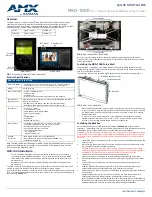
Ver. 2.0U Dec. 4, 2008
- 1 - Installation Manual for PV modules
INSTALLATION AND USER MANUAL
FOR SHARP PHOTOVOLTAIC MODULES
ND-U230C1 / ND-U224C1 / ND-U216C1
ND-224UC1 / ND-220UC1 / ND-216UC1 / ND-208UC1 / ND-200UC1
NT-175UC1 / NT-170UC1 / NE-170UC1 / NE-165UC1
IMPORTANT SAFETY INSTRUCTIONS
This manual contains important safety instructions for the PV module that must be followed during the
installation and the maintenance of PV modules.
PLEASE READ THIS MANUAL CAREFULLY BEFORE INSTALLING OR USING THE MODULES.
PLEASE PASS ALONG THIS MANUAL TO YOUR CUSTOMER.
A) GENERAL MANUAL
A-1. INTRODUCTION
Thank you for choosing SHARP photovoltaic (PV) module
.
This
Installation Manual contains essential information for electrical and
mechanical installation that you must know before installing SHARP
photovoltaic modules. These modules are UL listed (UL 1703). This
Manual also contains safety information you need to be familiar with.
All the information described in this Manual is the intellectual property
of SHARP and is based on the technologies and experience that have
been acquired and accumulated over the long history of SHARP. This
Manual does not constitute a warranty, expressed or implied. SHARP
does not assume responsibility and expressly disclaims liability for loss,
damage, or expense arising out of or in any way connected with
installation, operation, use or maintenance of PV modules. No
responsibility is assumed by SHARP for any infringement of patents or
other rights of third parties that may result from use of PV modules.
SHARP reserves the right to make changes to the product,
specifications or Installation Manual without prior notice.
A-2. GENERAL INFORMATION
(INCLUDING WARNING AND SAFETY)
The installation of PV modules requires a great degree of skill and
should only be performed by qualified licensed professionals, including
licensed contractors and licensed electricians. Please be aware that
there is a serious risk of various types of injury occurring during the
installation including the risk of electric shock. These SHARP PV
modules are equipped with a permanently attached special cable
assembly for ease of installation which does not require special
assembly.
< GENERAL WARNING >
1.
PV modules are heavy. Handle with care.
2.
Before you attempt to install, wire, operate and maintain the PV
module, please make sure that you completely understand the
information described in this Installation Manual.
3.
Contact with electrically active parts of a PV module such as
terminals can result in burns, sparks and lethal shock whether the
PV modules are connected or not.
4.
PV modules produce electricity when sufficient sunlight or other
light source illuminates the module. When modules are connected
in series, voltage is cumulative. When modules are connected in
parallel, current is cumulative. PV systems can produce high
voltage and current which could present an increased hazard and
may cause serious injury or death.
5.
Do not connect PV modules directly to motor loads. Variation in PV
module output power as a function of solar irradiance may damage
directly-connected loads.
For example,
1: In the case of a brushless motor, the lock function may become
active and the motor may be damaged;
2:
In the case of a brush type motor, the coil may be damaged.
< GENERAL SAFETY >
1.
Install PV modules and ground frames and other metal
components in accordance with applicable codes and regulations.
2.
PV modules should be installed and maintained by qualified
personnel. Only installation/service personnel should have access
to the PV module installation site.
3.
Keep children away from PV modules.
4.
Prior to installation, do not store modules outdoors or in a damp
environment to prevent glass from damage due to white
efflorescence.
5.
When PV modules are installed on roofs or any other structures
above ground, appropriate safety practices should be followed and
appropriate safety equipment should be used in order to avoid
possible safety hazards. Note that the installation of PV modules
on some roof types may require the addition of fireproofing, as
required by local building/fire codes.
6.
Roof mounted PV modules are to be mounted over a fire resistant
roof.
7.
Only PV modules with the same cell size should be connected in
series.
8.
Follow all safety precautions of other components used in the
system.
9.
In order to avoid risk of injury or electrical shock, do not allow
anyone to handle damaged PV modules if the person is unqualified
or has limited knowledge of PV modules. Place defective PV
modules in cartons so PV cells are completely shaded, because a
defective PV module or module with broken glass may generate
power even if it is removed from the system.
10.
When installing PV modules in a readily accessible location, the
National Electrical Code (NEC) 690.33 requires installing the
additional locking sleeve (Multi-Contact part # PV-SSH4) on the
connector. Note that this sleeve is not included with the module.
This requirement is for circuits operating in excess of 30 volts,
nominal, maximum system voltage for DC or 30 volts for AC
circuits
.
11.
Avoid uneven shade on the PV module surface. Shaded cells may
become hot (“hot spot” phenomenon) which may result in
permanent damage to the module (e.g., solder joints may peel off).


























